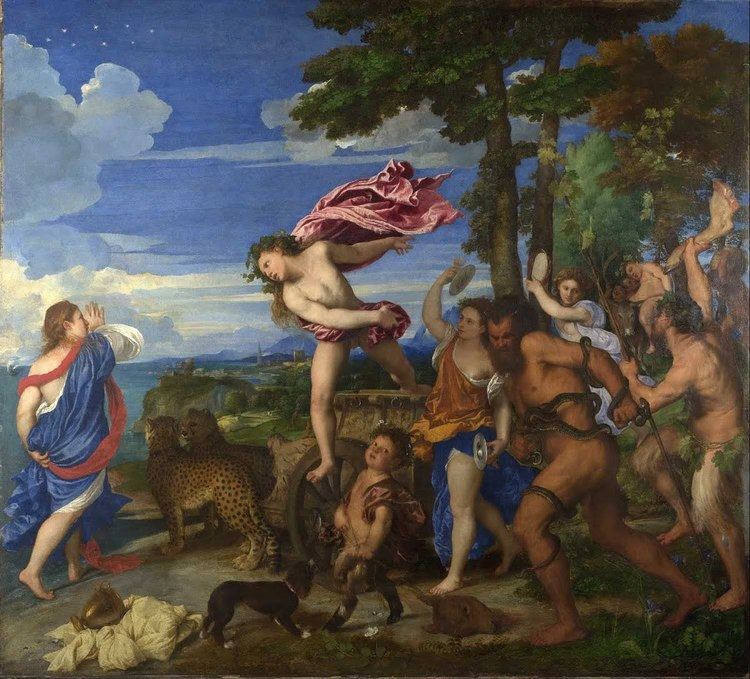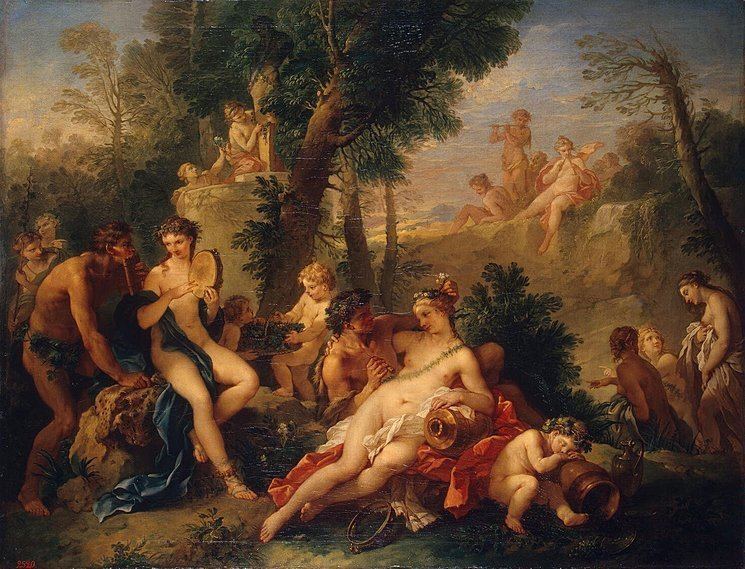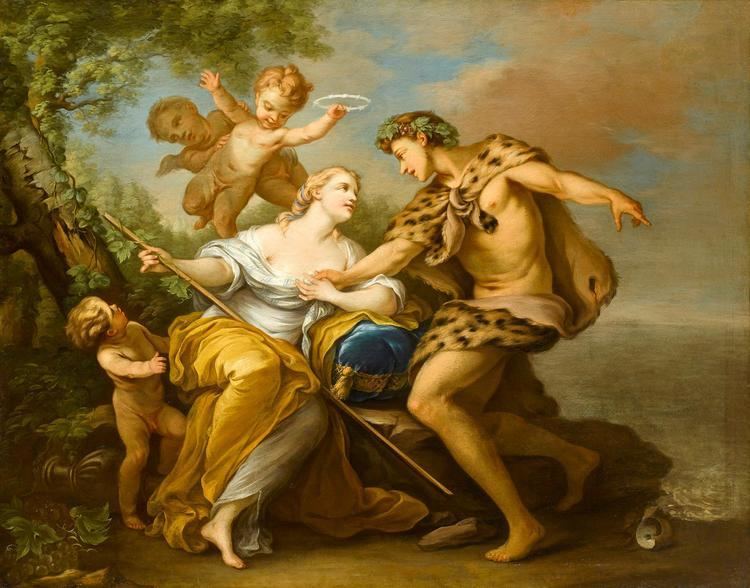Year 1522–23 Dimensions 1.75 m x 1.9 m Genre History painting | Created 1520–1523 Media Paint, Oil paint, Canvas | |
 | ||
Type oil on canvas (applied onto conservation board 1968) Periods Italian Renaissance, High Renaissance, Renaissance, Venetian school Similar Titian artwork, Artwork at National Gallery - London, Renaissance artwork | ||
Titian painting the myth of bacchus and ariadne national gallery
Bacchus and Ariadne (1522–1523) is an oil painting by Titian. It is one of a cycle of paintings on mythological subjects produced for Alfonso I d'Este, Duke of Ferrara, for the Camerino d'Alabastro – a private room in his palazzo in Ferrara decorated with paintings based on classical texts. An advance payment was given to Raphael, who originally held the commission for the subject of a Triumph of Bacchus. At the time of Raphael's death in 1520, only a preliminary drawing was completed and the commission was then handed to Titian. In the case of Bacchus and Ariadne, the subject matter was derived from the Roman poets Catullus and Ovid. The painting, considered one of Titian's greatest works, now hangs in the National Gallery in London. The other major paintings in the cycle are The Feast of the Gods (mostly by Giovanni Bellini, now in the National Gallery of Art, Washington, D.C), and Titian's The Bacchanal of the Andrians and The Worship of Venus (both now in the Museo del Prado, Madrid).
Contents
- Titian painting the myth of bacchus and ariadne national gallery
- Painting a story titian s bacchus and ariadne the national gallery london
- Description
- Restoration
- Painting versions
- References

Painting a story titian s bacchus and ariadne the national gallery london
Description

Ariadne has been left on the island of Naxos, deserted by her lover Theseus, whose ship sails away to the far left. She is discovered on the shore by the god Bacchus, leading a procession of revelers in a chariot drawn by two cheetahs (These were probably modelled on those in the Duke's menagerie and were tigers in Ovid's original text). Bacchus is depicted in mid-air as he leaps out of the chariot to protect Ariadne from these beasts. In the sky above the figure of Ariadne is the star constellation Corona Borealis (Northern crown). There are two possible variations of the story both going back to Ovid. In his Metamorphoses, Ovid has Bacchus throw the crown of Ariadne into the sky where it becomes the constellation Northern Crown. In Ars Amatoria, Bacchus promises the entire sky to Ariadne where she then would become the constellation Northern Crown. The National Gallery's website states that in the painting, 'Bacchus, god of wine, emerges with his followers from the landscape to the right. Falling in love with Ariadne on first sight, he leaps from his chariot, drawn by two cheetahs, towards her. Ariadne had been abandoned on the Greek island of Naxos by Theseus, whose ship is shown in the distance. The picture shows her initial fear of Bacchus, but he raised her to heaven and turned her into a constellation, represented by the stars above her head.'

The composition is divided diagonally into two triangles, one of blue sky (using the expensive ultramarine pigment) and still but for the two lovers caught in movement, the other a riot of movement and predominantly green/brown in colour. The follower of Bacchus who struggles with a snake is sometimes falsely associated with the antique sculpture of Laocoön and His Sons who had been killed by snakes. This statue had recently been discovered in Rome. But the satyr in Titian's painting is not in a mortal combat with the snakes, he is merely girding himself with them as is described in the original text by Catullus. The King Charles Spaniel that barks at the boy satyr is a common motif in Titian's work and was probably a court pet. The gold urn inscribed with the artist's signature (TICIANVS) may also have been familiar to the Duke as one of the antiquities in his collection.

The analysis of pigments used by Titian in this painting has been undertaken by scientists at the National Gallery in London and this analysis is illustrated at ColourLex.
Restoration
The canvas on which Bacchus and Ariadne is painted was rolled up twice in the first century of its existence, which had disastrous consequences for the painting. From the turn of the 19th century onwards it was frequently being restored to stop paint from flaking off, the last and most controversial restoration being that carried out at the National Gallery between 1967 and 1968. When discoloured varnish lying directly on top of the paint surface was removed, much of the paint itself came off as well and extensive repainting was necessary. This has caused some critics to note that the expanse of blue sky on the left-hand side, one of the worst-affected areas of the painting, appears flat and pallid. It has also been argued that the removal of the varnish has left the painting tonally out of balance, since Titian is likely to have added some subtle glazes to the paint surface in order to tone down some of the more jarring colors. The National Gallery maintains that this was an unavoidable loss, because the accrued layers of later varnish had turned the painting brown and sludgy and had to be removed.
Painting versions
Below are listed some of the principal paintings of the subject in museum collections:
